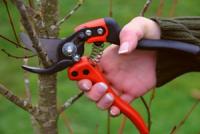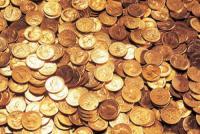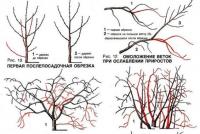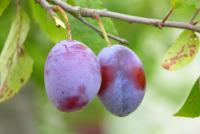Apple tree: planting and caring for the queen of the garden. Apple Orchard in numbers
Material prepared:
Mukhanin I.V.
President of the Association of Gardeners of Russia (APPAI), Doctor of Agricultural Sciences
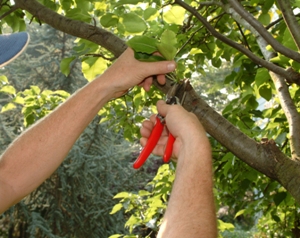
Schekotova L.A.
Candidate of Biological Sciences, scientific consultant of the Association ASP-RUS

Specialist of Association ASP-RUS, student of MichAU
Using material from Anita Łukawska
Industrial cultivation of pears in an intensive type garden
 Intense orchard pears during flowering
Intense orchard pears during flowering
Pear cultivation is an activity for patient, persistent, and appropriately experienced gardeners. This culture is quite demanding to the conditions of cultivation, it is especially sensitive to the harsh climatic conditions. Here I would like to talk a little about varieties and technologies that are used in European orchards of intense type.
It will be a question of one family farm the area of 38 hectares, from which 24 hectares are occupied by a pear, cherry - 2,5 hectares and 1,5 hectares - an apple-tree. The remaining areas are arable land.
 Trellis dwarf orchard pears
Trellis dwarf orchard pears
The farm cultivates both summer ripening varieties and those suitable for long-term storage. All this makes it possible to realize pears almost all year round (in 2012, the last pears were sold in June, and the first harvest was collected in August). More than 20 varieties have been planted, some of which have not yet brought profit - revenues go only to pay taxes, store and sell fruits. Summer varieties in the garden are cultivated Alfa (Alfa), Isolda (Isolde), Supertrevoux (a kidney variation of the variety Trawinka), Radana (Radana), Margerita (Margarita), Faworytka (Favorite) and Bonkreta Williamsa (Williams). Varieties suitable for long-term storage: Conference clone M 202, Noyabrskaya, Cheremshina and Lukashovka. Currently, marketable products are obtained from the pear varieties Favorite, Conference, Williams, Lukashovka and Noyabrskaya. Most of the varieties (including in all young plantations) grows on the Pigwa S1 stock, the smaller part grows on the Caucasian pear. For the variety Radana, the use of the Comisage insert is used, sometimes the same insert is used for the Conference variety. In both cases, the stock - Pigwa S1. The oldest pear variety, Williams, grows on the Caucasian pear, while for young plantations, they use Comissue as a stock.
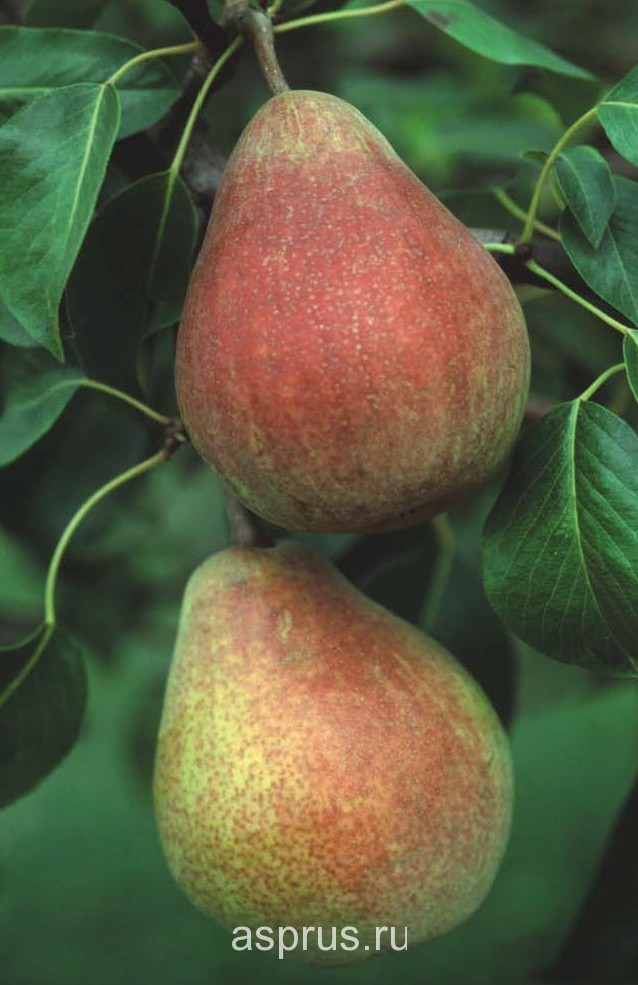 Pear Sort Favoritka
Pear Sort Favoritka
A fertigation system is installed on the entire area of the garden; about 15 hectares of plantations are covered with a hail net with a mesh size of 3 mm x 7 mm. The network is mounted on pre-set reinforced concrete pillars (for 2.02 ha), as well as on impregnated wooden poles (4.05 ha). Investments were received for the laying of the garden, allocated in accordance with the State Program for 2007-2013. "Modernization of agricultural production in Poland." This year, one quarter of the garden will be closed by various types of network (crystalline, black with twisted monofilament and zebras) in order to assess which type of them is most suitable for pears in local conditions. During the flowering of trees, pollinators are brought into the garden - bees, bumblebees.
Garden fertilizer
 I.V. Mukhanin doctor S.-H. Sciences on the industrial plantation pear varieties Dikolor
I.V. Mukhanin doctor S.-H. Sciences on the industrial plantation pear varieties Dikolor
Fruit and vegetable crops grow on fertile, loamy soils with a high-capacity sorption complex. In the fall of 2012, soil liming was performed. Used slaked lime (500 kg / ha). Last fall, 300 kg / ha of potassium (65%) were applied to the surface of the pristvolnoye herbicidal strip. In the spring of 2013, the main complex granular fertilizer and fertilizing was introduced - YaraMila Cropcare and Mikro 11-11-21 in an amount of 200 kg / ha. In addition, in some farms Yara LivaTropicote fertilizer (150 kg / ha) was applied in early April. In spring, the soil in pristvolnyh bands was sprayed with the Humistarem herbicide solution decomposing in the light, containing humic acids (12%) and fulvic acid (3%): 20 l / ha was dissolved in 250 l of water. In the following days, Ultraferro was added using the same method, containing iron, which is necessary for pear fruits, in a dose of 5 kg / ha, also dissolved in 250 l of water. The basic conditions for fertilizer application are wet soil and a clean sprayer. After the trees bloom, another dose of Humistaru (10 l / ha) is fed through the drip system. Before planting new trees, their roots must be treated with Pralumusie. The drug Gumistar (root growth stimulator) contributes to the retention of moisture around the roots and nutrients necessary for the development of the root system. According to some researchers, it improves the development of trees during the first two years and inhibits secondary growth.
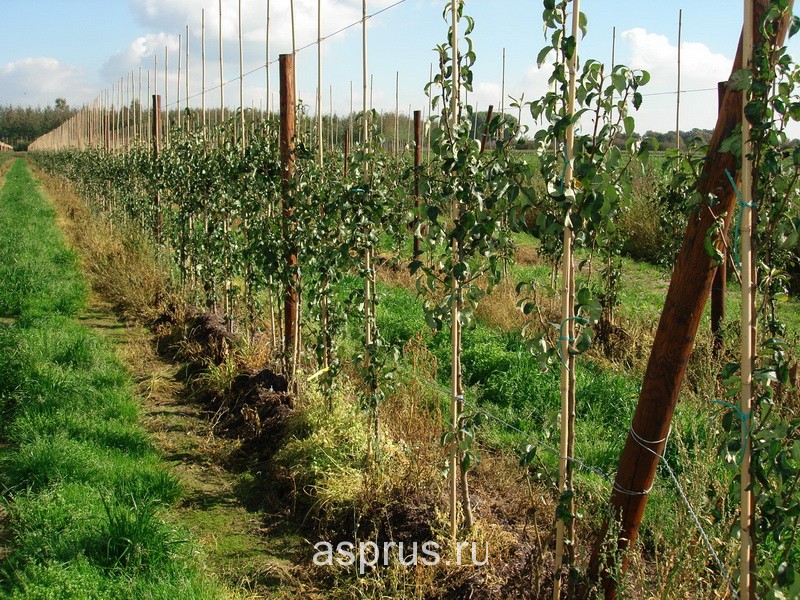 Intense trellis dwarf orchard pear
Intense trellis dwarf orchard pear
Fertigation in an intensive pear orchard
The garden is planted in one array, so one pump works on the entire fertigation system, providing drip irrigation of plants. Later a filter was installed to remove iron at the water intake. The valves for the individual modules are located in one place - in the building, which is the center for determining the quality of the water supplied, filters are installed here, mortar tanks for fertilizer application and control of the entire process is exercised.
Determination of the amount of water consumed, irrigation time, depending on the performance of droppers (liters per hour), the duration of the irrigation cycle are basic information for setting up and operating the equipment when applying fertilizers. The operation of the installation is programmed on a computer, and it automatically turns on and off. The equipment automatically regulates the process of water supply.
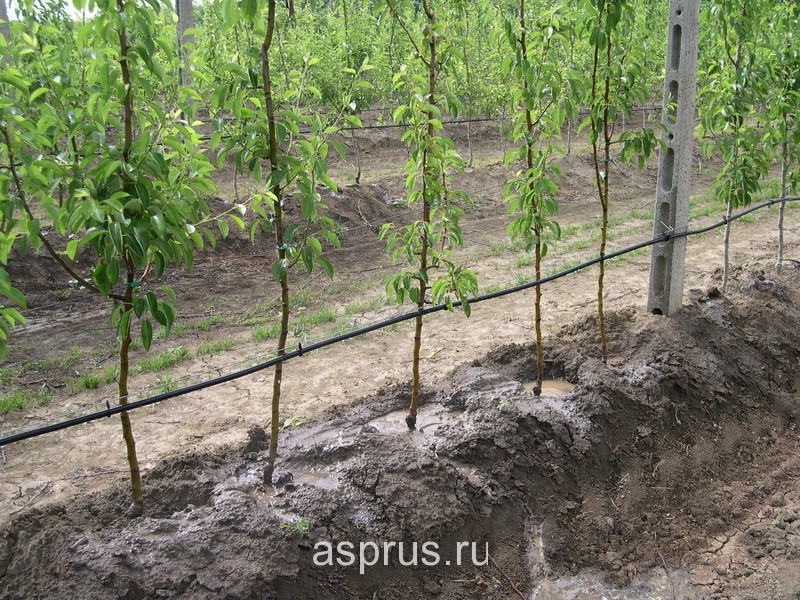 System drip irrigation and fertigation pear orchard
System drip irrigation and fertigation pear orchard
Fertigation of pears is carried out in accordance with the program developed by Yara Poland, which is adjusted depending on the soil composition (based on a regularly conducted analysis of the soil), the needs of trees, their condition, climatic conditions and expected yield.
After collecting the fruit to stimulate the development of generative buds, accelerate the lignification of the shoots and reduce the spread of pests of the pear tree, foliar fertilization with potassium nitrate is carried out every seven days. Moreover, zinc-boron is usually added to the solution.
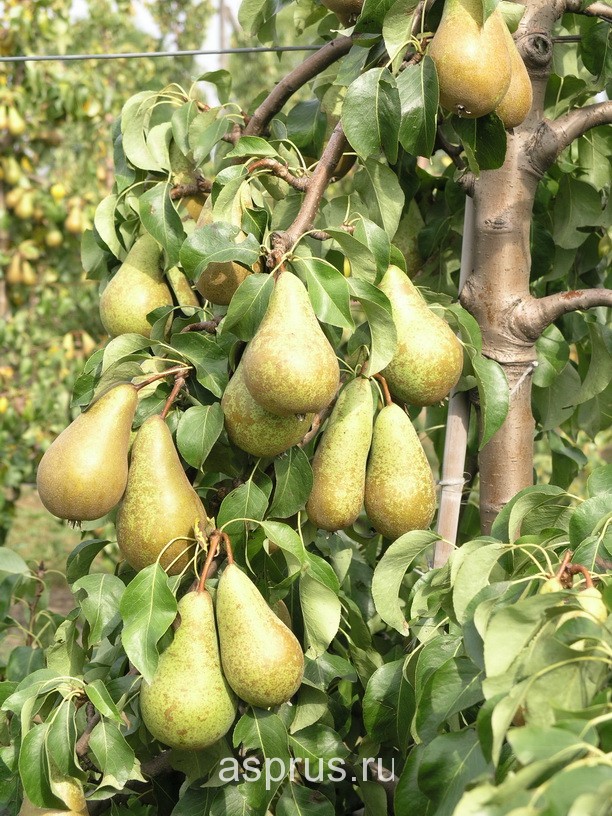 Quality fruit varieties pear Conference
Quality fruit varieties pear Conference
Protection of the pear orchard from pests
Garden protection comes, first of all, to the fight against spotty psillidah - leaflets, damaging the pear. The spread of this insect should be monitored regularly. It causes premature abscission of leaves and fruits. Leaves rich in feeding on nymphs and the black fungus settling on it cover black leaves with leaves and branches and fruits. Damaged fruits acquire an ugly shape and a woody texture that makes them unsuitable for consumption.
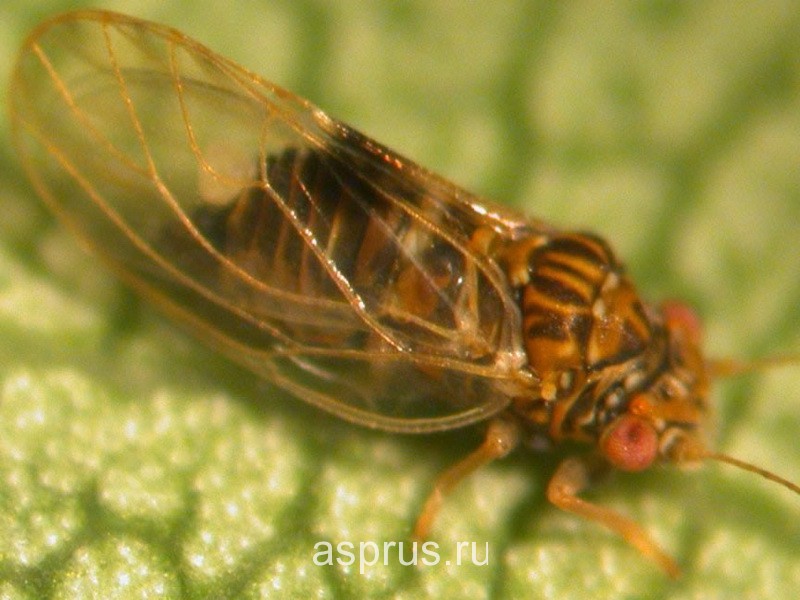 Pear leaf cover - one of the pests in the pear garden
Pear leaf cover - one of the pests in the pear garden
In the spring, before leafing, use Fastak 100 EC.
To limit the number of ticks, some gardeners resort to kerosene treatments. It also reduces the number of larvae of the sucker. The use of sulfur for foliar feeding of pears at the beginning of spring selectively works against the sucker. Before the flowering of pears, you can use kaolin, and after flowering you need to carry out chemical treatment. In 2013, Akaramik 018 KE was used for this. Specialists in pear protection believe that if one does not miss the appearance of the first generation psillid on a pear, the number of subsequent generations of predatory insects will be low.
To ensure the normal growth activity of trees, 500 l of water / ha are consumed per irrigation. 750-1000 l / ha is required to protect trees from pests per spray. Plant treatment can be carried out with a Caffini trailed sprayer.
Pear fruit realization
 Industrial Pear Sort Favorite
Industrial Pear Sort Favorite
In recent years, Favoritka and Williams pear varieties have been successfully sold. Demand forms a plantation structure in horticultural farms, which will ensure continuous supply of fruits to the market throughout the year. Fruits for sale are grown in accordance with the requirements of the consumer.
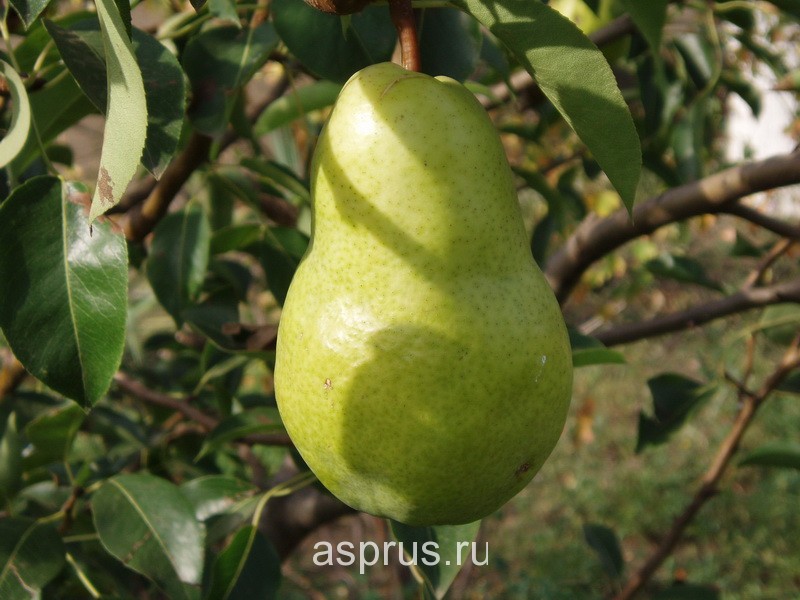 Industrial Pears - Williams
Industrial Pears - Williams
Begin business with fruit cultivation with the registration of a gardening non-profit partnership (SNT). Documents submitted to the tax office. Registration takes about 8 days. Mandatory payment of state fees.
The fruits grown by you should correspond to such state standard specifications:
- - General specifications for dried fruit.
- - Fresh apples sold in retail outlets. Technical conditions.
New landing technology
 For the most part, the result of apple business depends on the geography and variety of trees grown. But gardening is improved every year. New technologies offer great opportunities and significantly reduce the time of cultivation. Follow our recommendations and get the following result:
For the most part, the result of apple business depends on the geography and variety of trees grown. But gardening is improved every year. New technologies offer great opportunities and significantly reduce the time of cultivation. Follow our recommendations and get the following result:
- after 1 year - 15 tons / ha;
- after 4 years - 35 tons / ha;
- after 6 years - 50 tons / ha.
The success of these technologies depends on the planting of tall varieties on dwarf rootstocks of high density planting of apple trees, the correct pruning of crowns. For tall varieties include:
- Golden Delicious;
- Red delights;
- Joanred;
- Simorenko;
- Aydored;
- Starking;
- Grand piano delishes;
- Steyman
You can choose the right variety for your area by yourself. The necessary information can be found on the Internet.
The business plan of an apple orchard is an area of 1 ha. Trees are planted in 2,000 - 5,000 apple trees per 1 hectare. Use the most popular dwarf stock M9. This is an international standard. Grafting apple trees to M9 will shorten the term of fruiting up to 1 year. A single drawback - the roots are in the upper layers of the earth. Because the cold resistance of all -11 ° C. To adapt to low temperatures, sprinkle tree roots with earth.
How farmer Valery Zhomer works in gardening
Required equipment
At present, the initial entrepreneur is expensive to buy equipment. An alternative option is to buy equipment in or out of the first income. More information about the equipment for the care of the garden can be read. To improve earnings for growing apples, we recommend to purchase the following equipment:
- Car / van / tractor with trailer - for transporting fruit;
- Chainsaw or electric saw - for cutting dead trees;
- Cutter - to remove broken and diseased branches;
- Install an automatic watering system for trees - this will free up your time for other important tasks.
Preparing for landing
First, make a plan proper fit apple trees. Not only the health and quality of the fruit, but also your reputation depends on it. For this:
- plow the land;
- when planting, consider the distance of the hole, which is compared with the diameter of the seedling root;
- fill the dug holes with water;
- place the cut roots of the seedlings to cover the ground;
- prepare the necessary soil by forming a place for irrigation;
- water the trees.
Land for the garden is still in the fall, and the landing itself is carried out in the spring. Trees should not obscure each other. Therefore, consider planting a garden. A better consult a specialist. The plantation for apple orchard depends on the type of pruning:
Prepare wells for seedlings:
Hole: At the bottom, lower 25 kg of peat-distillation mixture and 40 g of phosphorus-potash fertilizers.
Garden care
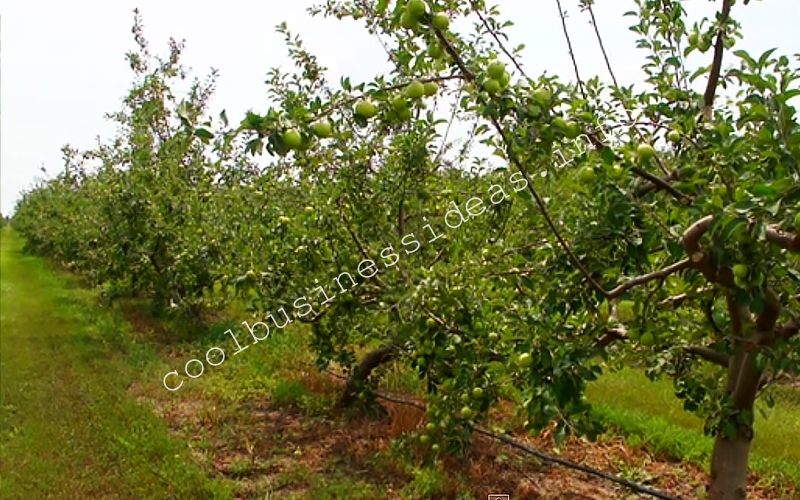 Apple garden as a business must take into account the constant care of the garden. The first is to buy. Release soil around the trunk from weeds. Do not work the soil mechanically with a garden cutter. Cover with dry needles of coniferous breeds, chips from bark, treat with herbicides. Processing is done in the absence of wind. For this fit Simazin, Kerb, Roundup, Glyphosate, Fosulen and other popular types of herbicides.
Apple garden as a business must take into account the constant care of the garden. The first is to buy. Release soil around the trunk from weeds. Do not work the soil mechanically with a garden cutter. Cover with dry needles of coniferous breeds, chips from bark, treat with herbicides. Processing is done in the absence of wind. For this fit Simazin, Kerb, Roundup, Glyphosate, Fosulen and other popular types of herbicides.
Treat the trees from insects. Use different types of insecticides, for example, Benzophosphate, Olekuprit. If this is not done harmful insects significantly reduce your crop or completely destroy it.
Seed pruning: leave 6 buds from the height of the stamp (from 80 cm).
Cut the grass between rows. If you use a mower that will chop the grass, then use the grass as a cover for the soil. Remove ground grass.
Be sure to provide trees with supports. For example, concrete pillars (height 1 - 2 m), buried in the ground at a distance of 25 meters with wire stretched. Or use pine cola (height 2 -3 m). But first, treat them with antiseptic. Thanks to the supports, the tree will grow in a vertical position, and the branches with apples will not break.
Some facts:
- the garden bears fruit for several decades;
- the life of an apple tree is about 50 years;
- the peak of the highest yield falls on 10-15 years of life with a further decrease in fruiting.
Harvesting and Storage
To get the expected income, the crop must be properly harvested and stored. Fruit harvesting usually occurs in September. A characteristic indicator is the acquisition of the skin of a characteristic color and ripening of the stone, which becomes brown.
In winter and autumn varieties distinguish removable and consumer maturity. To the product was usable, it is placed in storage for further maturation.
Fruit harvesting requirements:
- the collection is carried out manually in cool weather;
- be sure to preserve the stem;
- on the surface should not be damaged;
- the product cannot be poured, only shifted;
- fruits that have fallen to the ground are collected in a separate container;
- apples are recommended to be put in wooden boxes;
- fold the fruit in layers, separating it from the previous one with a sheet of paper, and cover it with a sheet on top;
You do not need special equipment for storing apples. The basement will be a good place to store. Monitor the temperature, keeping it within 0-2 ° C. You can keep a fresh look until April, collecting autumn and winter varieties.
Selling apples
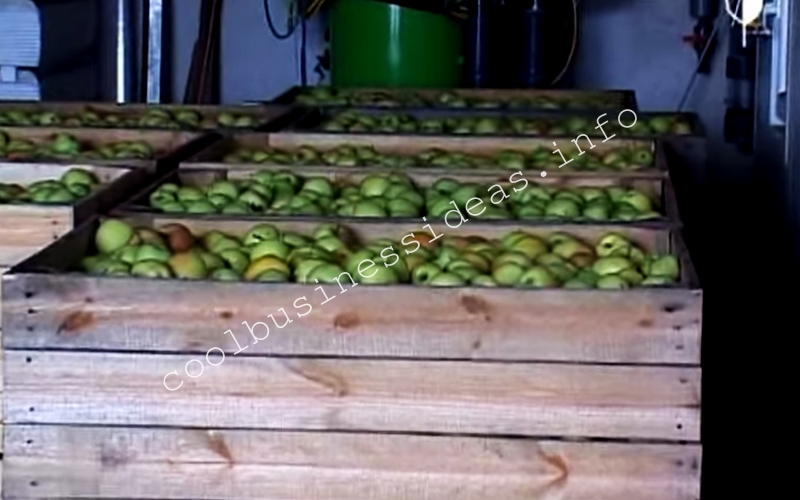 Growing apples as a business provides several optimal options for marketing products:
Growing apples as a business provides several optimal options for marketing products:
- in case of small quantities of apples: sales in the city’s markets, wholesale distribution to merchants, delivery of apples to baking sites;
- with large quantities of apples: the sale of goods to large supermarkets, the supply of apples to manufacturers of wine, cider, jams, compotes, jam, vinegar.
Landing orient from the purchased varieties of apples. This fruit is very much appreciated among wholesalers and regular buyers. If the territory, as well as cash allow, build a warehouse for storage. When selling apples in the winter, profits increase by 50%.
The business of growing apples is a win-win option based on households. Even if you have not fully realized your product, you can additionally open it, which will not only save your product, but also increase profits.
Apple Orchard in numbers
The use of intensive cultivation of apple orchard will raise your business to industrial heights in just 3 to 4 years.
Stable profit is provided every year.
Seedlings cost - from 180 rubles / pcs.
The cost of garden arrangement:
| Cost item | Cost, rub.) |
|---|---|
| Registration SNT | 12 000 |
| Saplings | 360 000 - 900 000 |
| Garden design | 3 000 |
| Soil preparation | 3 700 |
| Planting seedlings | 300 000 |
| Watering organization | 4 000 |
| Installation of supports | 320 000 |
| Special equipment | 3 080 000 |
| Total | 4 082 700 - 4 622 700 |
Monthly expenses:
Garden guards only hire during the ripening season. Seasonal workers are required to harvest. At other times, the number of employees should be minimal. Perhaps you can do it yourself or turn apple growing into a family business.
Payback business on apples - 3 - 4 years.
Profitability reaches 100%.
During the season, apples are sold at a price of 50 rubles. for 1 kg.
In the winter season, this price increases by 3-4 times.
The tainted fruits can be sold for industrial processing at a price of 20 rubles. for 1 kg.
In the first yearprofit from the crop will be from 750,000 rubles. With each tree you get about 8 kg of crop. Every year the amount of the harvest will increase.
Risks
Before starting a business, it is necessary to analyze all possible risks. This business has such risks and ways to prevent them:
- crop failure - calculate your own expenses for crop insurance;
- loss of liquidity in case of uneven sales - when raising a loan, you must return the funds in payments during the seasonal period with the possibility of a delay and long-term repayment of the loan;
- lower prices for products - agree on the supply of products in advance;
- untimely technological operations due to inexperience - strict execution of the planned plan for the cultivation technology.
Timely analysis and identification of risks will help you in the future to avoid possible mistakes and financial losses.
Additional income

Also, stable earnings can be obtained on a new and profitable business for the production and cultivation of caramelized apples. This will require:
- caramelizer;
- caramel mixture, water, sugar;
- chopsticks;
- dressing (chocolate, nuts, powder, sesame, sugar powder);
- apples
Apple - 7 rubles.
Caramel - 3 rub.
Other expenses - 3 rubles.
Net profit: 60 - 13 = 47 rubles. from one apple.
For a day in public places you can sell 200-300 apples, and at large events from 500 apples.
47 x 300 (average sales) = 14,100 rubles. for one event.
What else to do in the fresh air?
1. The fruitful and tasty berry can become the key to a successful business. Quick implementation contributes to a monthly profit of 130,000 rubles.
2.. This is the most popular vegetable in the field of agriculture. Business profitability is more than 150%. The product has a high buyability, especially at the end of the summer season.
3. - A Frequent Question of Residents countrysidehaving a plot and a desire to make money on this business idea. This type of business has a profitability of 35-40%. Minimal competition and high demand for this product give an opportunity for good earnings.
4. in your garden. Sea buckthorn is not only a useful product, but also has a multifunctional use in cooking, folk and scientific medicine, cosmetology, which makes it possible to quickly find a point of sale for the product.
5. wishing to earn the value of this berry does not fall until the end of the season. Income easily pays back costs at the initial stage!
Presenting an orchard without an apple tree is simply impossible. A variety of varieties grown in garden plots produce the highest yields among all fruit trees. Such a great popularity of the apple tree is explained by the fact that the tree is quite unpretentious, can adapt to any climatic conditions, even the most extreme, and give good harvestwhen other fruit trees won't even grow. But in order to regularly collect fruits, it will take a year-round systematic proper care for the plant.
Soil for apple trees
The best soil is medium, slightly acidic, well-drained loam, but varieties for processing are grown in heavy soil with relatively poor drainage. Light sandy soil with organic fertilizers and abundant mulching will also be suitable. But the poor soil with a carbonate base is not suitable because of chlorosis, which is caused by excessive alkaline reactions.
The landing pit needs to be prepared in advance, about a month before planting, in order for the soil to shrink. The holes are dug to a depth of about 60 cm with a diameter of about 1 m, while the soil removed from the pit is mixed with organic fertilizers. If earlier other cultures grew here and the land was fertilized, then new ones are not needed. Unnecessary feeding will accelerate the growth of the tree, but at the same time reduce the yield.
As a rule, apple trees are planted in the dormant period: in the spring before, as the buds blossomed, or in the autumn after the leaf fall. Autumn planting two or three weeks should be completed before the onset of frosts, otherwise new roots will not have time to form.
Before planting, carefully inspect the roots of seedlings, cut off the dead and rotted parts, remove the leaves. In the pit, the seedling is placed on a hillock of the earth, the roots are straightened. They fall asleep in such a way that the ground around the roots becomes denser and no voids form.
Attention: The tree sets in such a way that the root neck is level with the soil surface. Apple trees, planted deep, grow poorly and bear fruit just as badly.
Care
In order for the apple trees to delight their owners with excellent crops, they require skillful care. Trees should have adequate nutrition, moisture and other factors necessary for life support. It is also important to provide.
Top dressing
Experienced gardeners know how to feed an apple tree in the summer, autumn or spring, because timely and proper fertilization of fruit trees is the key to successful and healthy fruiting. The apple tree is not an exception and also needs periodic feeding. Fruiting trees are fertilized 3-4 times per season for the purpose of growth, fruit set and further development.
An excellent effect will be provided by foliar feeding of apple trees with a solution of growth stimulants, which will increase the resistance of the tree to diseases, freezing, drought, and will accelerate the time of fruit ripening.
Watering
Culture loves moisture, so you need to water regularly. The first watering is carried out immediately after flowering. The amount of water for irrigation depends on precipitation and soil moisture. Then it is necessary to water as necessary, focusing on the general condition of the soil.
Fault protection
When a bountiful harvest pleases, you need to take care of protecting the tree from breaking under the weight of pouring apples. To maintain the branches, set the chatala - strong props of different lengths with a slingshot at the top.
For better fruiting and growth, the crown of the apple must be formed. Without this method there will be easy breaking of the branches, one-sided branching, thickening of the crown, etc. All this will lead to a decrease in yield, and sometimes to death from a fracture. The crown formed will create a good illumination of all parts of the tree, provide strength and excellent attachment of the branches. The formation of the crown of an apple tree maintains the correct ratio of its growth and fruiting, the old branches are replaced by young ones and thus the tree rejuvenates.
There are many methods of crown formation. May be configured as:
- rarefied;
- combined;
- spindle, etc.
Attention: The branches that appear below the first skeletal branch are completely removed.
 The sooner the crown begins to form, the easier and more successful this operation will take place. Annual regular formation begins after the first pruning of an apple tree at the age of two years. Best time - early spring, before the start of sap flow.
The sooner the crown begins to form, the easier and more successful this operation will take place. Annual regular formation begins after the first pruning of an apple tree at the age of two years. Best time - early spring, before the start of sap flow.
The apple tree is the pride and beauty of our gardens. It pleases the eye both in the spring with its flowering and in the fall, with flowing fruits. No fruit is kept fresh like this until spring, or even until the new harvest. Apples are made into compotes, juices, jam, apple cider vinegar, etc. Finely chopped fruit is dried in the sun to make dried fruits and compotes. Fruits are suitable for making marmalades and jellies.
Due to the unique variety of nutrients, effective in the treatment and prevention of certain diseases of the digestive system. Used to rejuvenate and cleanse the body. And the biblical story says that the independent life of people began with the apple.
Video "Planting Apple Saplings"
How to plant apple seedlings correctly, see the video:
♦ Category:.
The article says about such fruit trees like: plum, pear, apple, apricot and peach. A few words about the rules of planting plants, as well as about beneficial properties fruits.
Unlikely among owners garden plot He will be found who in secret does not dream of a large flowering and fragrant garden. Let small, but well-groomed and fructifying. To create such a paradise and achieve maximum yield of trees, it is necessary to possess some knowledge and skills, as well as to take into account some aspects.
It is important to pay attention to planting material. It is no secret that the better it is, the better the harvest will be. The soil for planting such trees should pass air well and retain moisture. It is necessary to properly prepare the trees for planting. A huge role in this is played by the size of the holes for planting, the location of the roots and the correct watering. It is important to remember about the correct pruning of shoots.
Of course, for each fruit tree has its own individual characteristics. And compliance with the rules when planting, as well as proper care, will provide annual, abundant fruiting. What cultures are best to plant in your garden?
Peach
For example, peach is a very light-loving culture. Landing is best done in the spring, in March. And it is important to know that a rich harvest without irrigation does not get. Therefore, immediately after planting the peach, it must be watered well. But, irrigating peach trees, it is not necessary to allow remoistening.
Huge value for the crop is played by correct crown shaping. To do this, as you know, remove the dry damaged branches and highly branched growths that thicken the crown. Peach Fruit useful composition. It contains various organic acids: tartaric, malic, citric. As well as such mineral salts as iron, phosphorus, potassium, manganese, copper and magnesium. In addition, these fruits are rich in vitamins groups B, C, and carotene.
Apricot
Apricot - heat-loving culture. For its landing it is necessary to choose a sunny place, warm and well protected from the winds. And to plant an apricot in the spring should be when thawed earth. It is also possible in autumn, in September, but in this case it is necessary to remove excess shoots and shorten too long. Apricots can also be planted in late autumn, after leaf fall.
Apricot should be watered regularly, especially after transplants and during growth (May - June). Apricots saturate the body with vitamins and microelements. Used in diseases of the kidneys, cardiovascular system and anemia. In addition, the fruits of apricot increase brain activity and improve memory.
Apricots contain a lot of sugar, carotene, carbohydrates, proteins, organic acids and fiber, provitamin A, as well as vitamins of groups B and C. However, apricots are contraindicated for those who suffer diabetes mellitus, gastritis and obesity due to the high sugar content.
Apple trees
Apple trees - light-loving culture, although hardy and in the shade. Favorable conditions for them are black soil with medium fertility. Acidity on such soils should be weak. They plant an apple tree, usually in spring (May) or autumn (September). The size landing pit should be such that the roots of the seedling fit freely in it. It is not necessary to sprinkle the roots with fertilizers in order not to burn them. After planting, the tree can pour 3-4 buckets of water. Apple tree is demanding of moisture, so it must be watered regularly.
Apples regulate the activity of the digestive system and the gastrointestinal tract. Used to prevent constipation. Very helpful, they contain vitamins. C, P, B1, B2, Eand also mineral substances: calcium and potassium, phosphorus, iron, manganese, magnesium, sodium, sulfur. Apples reduce blood cholesterol and are recommended for vitamin deficiency and anemia.
Pear
For planting pears choose a very bright, dry and level place. For better
Pollination is recommended to plant several varieties. The soil for this must be loose, breathable, able to retain moisture, and also rich in nutrients. Gardeners are advised to prepare seedlings for planting in the fall. If the soil is loose - pears are watered often, in small volumes, if the soil is more dense, then less often and in large volumes.
Pear contains a large number of nutrients: glucose, sucrose, fructose, vitamins A, B1, B2, E, PP, and C. In addition, carotene, mineral salts, manganese, iron, iodine, copper, calcium and fiber. It is recommended to use a pear in violation of the pancreas. Pear is involved in the normalization of the heartbeat, stimulates the activity of such important organs as the kidneys and liver, and simply improves mood.
Plum
Plum prefers heat, moisture and of course light. Therefore, it is necessary to plant a plum from the sunny side, where cold winds are unlikely. The tree does not tolerate drought, so it is not recommended to plant a plum near trees that can take the necessary moisture from it. Plums can be planted in the fall and spring. Planted tree abundantly watered. Plum is less demanding on watering than an apple or pear tree, it is recommended to water the trees with an interval of 7-10 days.
These are the trees you can plant in the orchard. They will surround you not only with beauty but also protect you from diseases. And what a smell in this garden in the spring!

